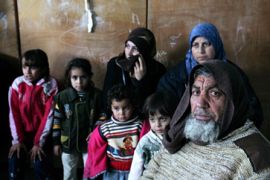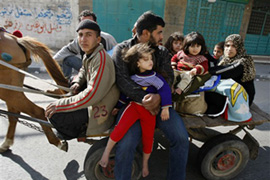Displaced and desperate in Gaza
Palestinians say Israel’s assault on Gaza evokes memories of the ‘nakba’.

 |
| Those who lived through the Palestinian ‘nakba’ say the current situation in Gaza evokes memories of that time [GALLO/GETTY] |
During the course of the Israeli air, ground and sea assaults on Gaza there has been a considerable shift in the nature of the offensive.
The aerial and ground attacks have risen in volume and ferocity and have shifted focus from civil security offices, public service buildings and mosques, to random bombardment of entire neighbourhoods, empty fields within the periphery of these neighbourhoods and vacated or partially vacated buildings.
Now, Israeli forces have taken to directly targeting and destroying residential buildings and homes, civilian cars transporting entire families and schools that provide shelter for the thousands of displaced families in the Gaza Strip.
‘Tomorrow never comes’
The United Nations Relief and Works Agency (Unrwa) schools turned shelters have provided cover from the rain and cold for many displaced Gazans but they have failed to provide protection from Israeli missiles.
Although 45 people were killed when a UN school in the northern city of Jabaliya – where 350 Gazans were taking shelter – was hit, those that survived have had little option other than to remain living in the building.
| IN DEPTH |
 Latest news and analysis from Gaza and Israel |
 Send us your views and videos |
 Watch our coverage of the war on Gaza |
As in all of the 34 UN schools housing refugees in Gaza, those in Jabaliya sleep on the floor with little in the way of basic necessities.
Jalal is a 22-year-old engineering student whose home in the Zeitoun area of Gaza City was only a few metres away from the home of the Samouni family. When the Samouni family home was bombed, leaving 30 people dead, on the second day of the ground offensive, Jalal, his parents, brother and four sisters fled and took refuge in a Unrwa school.
“The first night of the ground incursion we all slept in the kitchen,” Jalal said.
“The second day phosphorus bombs fell on our backyard and the barn, setting the hay and two animals on fire. Another came close to hitting my sister’s head as she was praying.
“They’re like balls of fire rolling on the ground.”
Jalal says that in the shelter, “four families are placed in each classroom, that means between 30 and 40 people”.
“It is cold at night and we went without food for 45 hours the first couple of days.
“Each day we tell each other that this day will be the last, that tomorrow we will go home and all this will end, but tomorrow never comes,” he says.
‘Nakba’ memories evoked
Jalal’s story echoes the accounts I have heard many times before from my grandfather and others who lived through the Palestinian ‘nakba’ or catastrophe in 1948.
|
“We tell each other that this day will be the last, that tomorrow we will go home and all this will end, but tomorrow never comes” Jalal, Gaza |
“We fled the bombing of British warplanes, we locked our house and hid in the hills for days, each day thinking that tomorrow we would return, but tomorrow never came,” my grandfather tells me.
“It has been 60 years and now it is happening again. This time we can’t walk south to escape the bombing, like we walked from Asdood to Gaza. This time they want us to jump into the sea.
“But we won’t, we’ll die standing with our heads held high this time. We’ve learned from the past that it’s better to die defending than to run and live.
“We’ve learned that life has no meaning when your roots, your birthright, your past and your present is stolen from you,” he says.
Sleeping outside
About 15,000 people have now been displaced across the Gaza Strip. In Rafah alone, 800 families have fled and in the past few days many thousands more have been called upon by the Israeli military to evacuate their homes and neighbourhoods.
A few days ago I went for a walk around my neighbourhood. I left my home early in the morning and headed toward what is known as the Rimal market, a busy shopping area in the centre of Gaza City.
As I turned into one of the streets leading off the market, I noticed people, wrapped in blankets, sleeping outside their houses in the street.
In the next street was the ruins of what had been a Palestinian security compound, once a landmark in Gaza City. It had been hit by Israeli warplanes on three separate occasions, despite the fact that it was almost completely destroyed in the first attack.
If it were to be hit again, the houses in the surrounding streets, which had already sustained serious damage, would be in danger of collapsing. So the residents had concluded that it was safer to sleep outside in the bitter cold than to remain inside their homes.
Fleeing homes
The next day a number of carts drawn by donkeys were seen coming into Gaza City. They were loaded with people; elderly men and women, mothers and fathers with toddlers in their arms, small children wrapped in blankets, and what looked like bundles of clothes.
 |
| Families are fleeing their homes all over the Gaza Strip [AFP] |
These people had fled their homes in the northern Gaza Strip and, with nowhere else to go, were seeking refuge in Gaza City.
Those not fleeing their homes have mainly been confined to them for days on end, without water, electricity or sufficient food.
A few days ago, a man called into a radio station and called on the Red Cross to try to reach his home in the Zeitoun area. He said the body of one of his relatives had been in his home for four days and that the family had been unable to leave the house to bury him because of constant heavy shelling in the area. The body was beginning to rot, he told the radio host.
As Israel continues its attack on the people of Gaza, all the while sticking to its claim that it is Hamas and not the Palestinian people being targeted, memories of the Palestinian ‘nakba’ are evoked across the Gaza Strip.